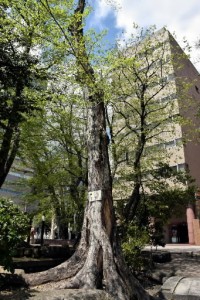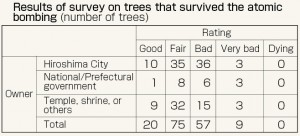161 A-bombed trees are examined, condition of 40% a source of concern
Apr. 19, 2017
by Kanako Noda, Staff Writer
On April 18, the City of Hiroshima released the findings of a survey of 161 trees that survived the atomic bombing. The survey carried out in fiscal 2016 found that 95 of these trees, or about 60 percent, are healthy, but there are concerns involving 66 trees, or roughly 40 percent. The city plans to conduct a regular check of the A-bombed trees in an effort to preserve these “silent witnesses” to the atomic bombing.
The municipal government commissioned Chikara Horiguchi, 71, a tree doctor, to conduct the survey of the trees between June 2016 and the end of March 2017. Mr. Horiguchi examined the trees visually and rated 12 aspects, including the density of their branches and leaves and the condition of their bark, evaluating the overall condition on a scale from one to five. A total of 95 trees, or 59 percent, were rated as “good” or “relatively good,” which means the trees are healthy for the most part. On the other hand, 66 trees, or 41 percent, were rated “bad” or “very bad,” meaning that their condition is deteriorating. No tree was rated as “dying.”
Nine trees were rated “very bad.” One of them is a muku tree, or scabrous aphananthe, which endured the bombing from a location about 530 meters from the hypocenter. The 13-meter-high tree still stands at the same spot in the Komachi area along Peace Memorial Boulevard. In some places, the bark is peeling, then withering and dropping off. This tree, among others, stands on land owned by the city government. But the city does not see the need to pursue urgent measures to help such trees recover. According to the city, it is not clear what part the atomic bombing has played in their growth and current condition.
The city, which has conducted surveys on a sporadic basis, has decided to carry out regular checks starting in fiscal year 2018. Based on the results of the latest survey, as well as the presence or absence of disease or pests, it has decided that 74 trees should be examined every five years, 44 every three years, 37 every other year, and six every year.
Starting in fiscal year 1996, trees that were exposed to the atomic bombing within a two-kilometer radius of the hypocenter have been registered as “A-bombed trees” by the city government. Currently, 84 trees are on city-held land and the 77 other trees are located on land held by temples, shrines, the Hiroshima prefectural government, the Japanese national government, and others. According to the city’s Peace Promotion Division, the city will provide the results of the latest survey to those concerned, explain the significance of preserving the trees, and encourage them to make use of the information to take appropriate action.
(Originally published on April 19, 2017)
On April 18, the City of Hiroshima released the findings of a survey of 161 trees that survived the atomic bombing. The survey carried out in fiscal 2016 found that 95 of these trees, or about 60 percent, are healthy, but there are concerns involving 66 trees, or roughly 40 percent. The city plans to conduct a regular check of the A-bombed trees in an effort to preserve these “silent witnesses” to the atomic bombing.
The municipal government commissioned Chikara Horiguchi, 71, a tree doctor, to conduct the survey of the trees between June 2016 and the end of March 2017. Mr. Horiguchi examined the trees visually and rated 12 aspects, including the density of their branches and leaves and the condition of their bark, evaluating the overall condition on a scale from one to five. A total of 95 trees, or 59 percent, were rated as “good” or “relatively good,” which means the trees are healthy for the most part. On the other hand, 66 trees, or 41 percent, were rated “bad” or “very bad,” meaning that their condition is deteriorating. No tree was rated as “dying.”
Nine trees were rated “very bad.” One of them is a muku tree, or scabrous aphananthe, which endured the bombing from a location about 530 meters from the hypocenter. The 13-meter-high tree still stands at the same spot in the Komachi area along Peace Memorial Boulevard. In some places, the bark is peeling, then withering and dropping off. This tree, among others, stands on land owned by the city government. But the city does not see the need to pursue urgent measures to help such trees recover. According to the city, it is not clear what part the atomic bombing has played in their growth and current condition.
The city, which has conducted surveys on a sporadic basis, has decided to carry out regular checks starting in fiscal year 2018. Based on the results of the latest survey, as well as the presence or absence of disease or pests, it has decided that 74 trees should be examined every five years, 44 every three years, 37 every other year, and six every year.
Starting in fiscal year 1996, trees that were exposed to the atomic bombing within a two-kilometer radius of the hypocenter have been registered as “A-bombed trees” by the city government. Currently, 84 trees are on city-held land and the 77 other trees are located on land held by temples, shrines, the Hiroshima prefectural government, the Japanese national government, and others. According to the city’s Peace Promotion Division, the city will provide the results of the latest survey to those concerned, explain the significance of preserving the trees, and encourage them to make use of the information to take appropriate action.
(Originally published on April 19, 2017)









